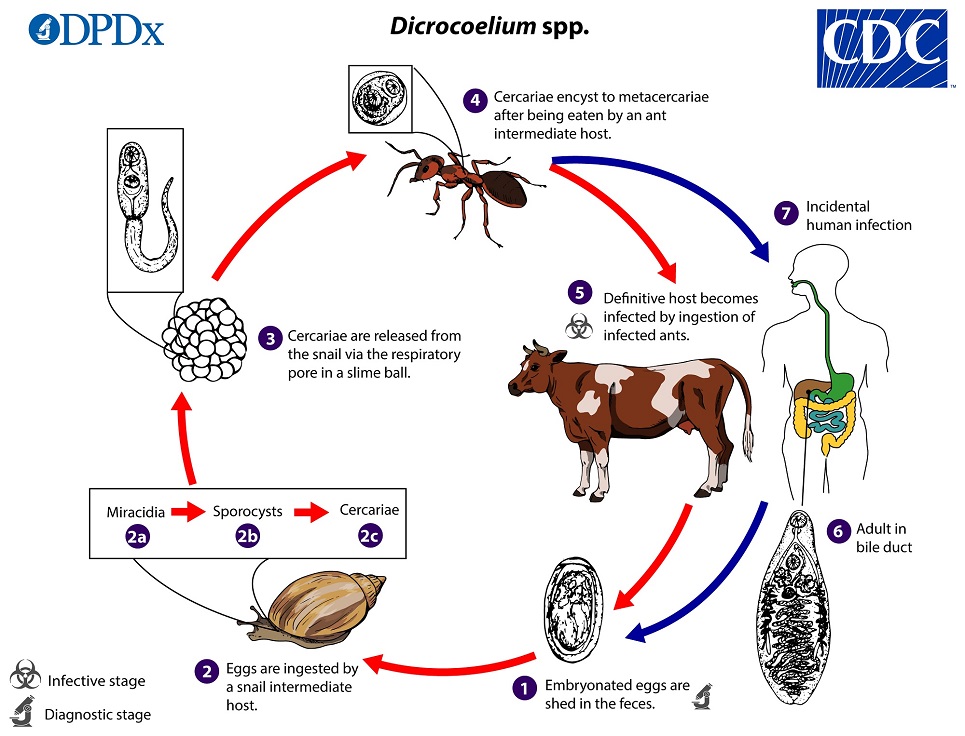
Dicrocoeliasis
[Dicrocoelium dendriticum]
Causal Agents
The trematode Dicrocoelium dendriticum, the lanceolate fluke or lancet fluke, is a common parasite of ruminants but humans can be accidental definitive hosts. Another species, D. hospes, is responsible for human infections in West Africa.
Life Cycle
Embryonated eggs containing miracidia are shed in feces of definitive hosts, which are typically ruminants  . The eggs are then ingested by the first intermediate host (snail)
. The eggs are then ingested by the first intermediate host (snail)  . When the miracidia hatch
. When the miracidia hatch  , they migrate through the gut wall and settle into the adjacent vascular connective tissue, where they become mother sporocysts
, they migrate through the gut wall and settle into the adjacent vascular connective tissue, where they become mother sporocysts  . The sporocysts migrate to the digestive gland where they give rise to several daughter sporocysts. Inside each daughter sporocyst, cercariae are produced
. The sporocysts migrate to the digestive gland where they give rise to several daughter sporocysts. Inside each daughter sporocyst, cercariae are produced  . Cercariae migrate to the respiration chamber where they are shed in slime ball from the snail
. Cercariae migrate to the respiration chamber where they are shed in slime ball from the snail  . After a slime ball is ingested by the second intermediate host (ant), the cercariae become free in the intestine and migrate to the hemocoel where they become metacercariae
. After a slime ball is ingested by the second intermediate host (ant), the cercariae become free in the intestine and migrate to the hemocoel where they become metacercariae  . When the infected ant is eaten by a suitable definitive host
. When the infected ant is eaten by a suitable definitive host  , the metacercariae excyst in the small intestine. The worms migrate to the bile duct where they mature into adults
, the metacercariae excyst in the small intestine. The worms migrate to the bile duct where they mature into adults  . Humans can serve as definitive hosts after ingesting infected ants (e.g. on contaminated food items)
. Humans can serve as definitive hosts after ingesting infected ants (e.g. on contaminated food items)  .
.
Hosts
Ruminants, especially cattle and sheep, are the normal definitive hosts of Dicrocoelium spp. Apart from humans, aberrant infections have been identified in various non-human primate species and domestic dogs.
First intermediate hosts include a wide variety of air-breathing land snail species, such as those in the genera Cochlicopa (=Cionella), Helix, Xerolenta (=Helicella), and Zebrina. Many different types of ants can serve as second intermediate hosts, especially members of the genus Formica.
Geographic Distribution
Dicrocoelium dendriticum is present in definitive hosts throughout Europe, Asia, and North Africa, and can be found sporadically in North America. Most of the known clinical cases have occurred in North Africa and the Middle East. D. hospes is endemic in sub-Saharan West Africa; cases have been documented in Ghana, Senegal, Sierra Leone, and Mali.
Clinical Presentation
Most infections involve low numbers of flukes and are not associated with overt symptoms. In more intense infections, symptoms may include cholecystitis, liver abscesses, and generalized gastrointestinal/abdominal distress. Occasional cases involving flukes in subcutaneous masses have been reported.
Dicrocoelium dendriticum eggs in wet mounts.




Dicrocoelium dendriticum adults.



Laboratory Diagnosis
Diagnosis is based on microscopic identification of eggs in the stool, duodenal, and/or bile fluid. Note that eggs may be detected in stool following consumption of liver infected with adult flukes; additional specimens should be collected to distinguish this spurious passage from a true infection. Adult flukes are rarely recovered.
More on: Morphologic comparison with other intestinal parasites
Laboratory Safety
Standard protocols for the processing of stool specimens apply. Dicrocoelium spp. eggs are not infectious to humans.
Suggested Reading
Jeandron, A., Rinaldi, L., Abdyldaieva, G., Usubalieva, J., Steinmann, P., Cringoli, G. and Utzinger, J., 2011. Human infections with Dicrocoelium dendriticum in Kyrgyzstan: the tip of the iceberg?. Journal of Parasitology, 97(6), pp.1170–1172.
DPDx is an educational resource designed for health professionals and laboratory scientists. For an overview including prevention, control, and treatment visit www.cdc.gov/parasites/.
